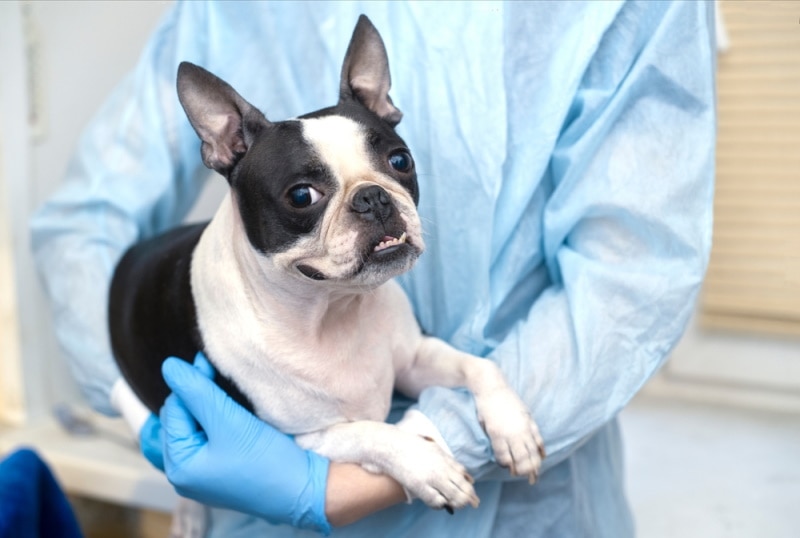7 Happy Dog Noises: Sounds That Mean Your Dog Is Happy
By Kit Copson
Updated on

We all wish we could read our dogs’ minds, but the closest we can get is reading their body language and working on understanding what they’re trying to tell us with their various vocalizations.
Dogs vocalize as a form of communication with us and other dogs. They vocalize to let us know when they’re sad, threatened, anxious, excited, and—the nicest one of all—when they’re simply brimming with happiness. In this post, we’ll explore the sounds a dog makes when they’re content and happy.
The 7 Happy Dog Noises
1. Barking
Decoding a dog’s bark can be tricky because they bark to express a wide range of emotions including fear, distress, excitement, and happiness. Fearful or stressed dogs tend to bark repeatedly in a high-pitched tone that sounds panicked.
On the other hand, high-pitched yapping combined with other “happy” body language like tail wagging, play bowing, or a calm or relaxed stance typically indicates happiness and/or that your dog is ready for a play session.

2. Growling
When dogs feel threatened, they may warn off the person or thing they perceive as a threat with a low, rumbling growl. However, not every type of growl indicates that your dog is feeling threatened —some growls indicate that your dog is having fun playing with you or other dogs. Dogs often growl while playing games like tug-of-war or play-fighting with their canine companions.
You can tell a playful growl when the dog is “grinning”, bouncing around, or laying on their back showing their belly so their playmate can “catch” them. When playing, some dogs do this as a kind of “Hey, you got me!” gesture.
On the other hand, aggressive growling is often accompanied by a curled lip, closed mouth, stiff posture, tucked-in tail, a hard stare, and/or pinned-back ears.
3. Snorting and Grumbling
Some dogs give off little snorting and/or grumbling sounds when they’re feeling excited, like when they see a tasty treat in your hand, or if the leash comes out when it’s time to go for a walk. Certain breeds snort due to their facial structure, though—particularly flat-faced breeds like Pugs and French Bulldogs. Snorting can also be a symptom of allergies or upper respiratory tract infections in dogs.

4. Sneezing
Believe it or not, play sneezing is a thing with dogs. Some dogs do it when they’re excited or having fun playing with you or another dog. If your dog is sneezing a lot even when not playing or is expelling white, green, or yellow discharge, they might have an infection or allergies and it’s best to consult a vet.
5. Whimpering and Whining
Dogs sometimes whimper or whine as a means of getting your attention or expressing excitement. For this reason, your dog might whine with happiness and excitement when they greet you at the door upon your return home.
You can usually tell happy whines because the dog will be wagging their tail or even bouncing up and down from the thrill of seeing you! Beware, though—whimpering and whining can also mean that your dog is in pain or is feeling afraid.

6. Sighing
Sighing is another way in which dogs express contentment. If your dog is falling asleep on your lap or next to you on the couch and gives off a sigh or groan, they’re likely feeling super relaxed. Some dogs sigh out of disappointment, though. If your dog is fully awake and sighs, it might be because they didn’t get to play with you when they wanted to or were denied a tasty morsel they had their eye on.
7. Howling
Dogs indeed howl to express sadness, as a response to certain noises, or to communicate with other dogs, but some dogs do it when they’re happy or excited, too. If your dog howls when it’s time for a walk, when they’re getting a treat, or when greeting you when you get home, they might simply be unable to contain their excitement!

Body Language: How to Tell a Dog Is Happy
In addition to listening to the sounds they make, watching your dog’s body language can tell you a lot about how they’re feeling. Here are some body language and habitual clues that a dog is feeling happy and content:
- Relaxed body posture
- Tail wagging
- Floppy ears
- Wiggly body
- “Grinning”
- Play bowing
- Short, high-pitched barks
- Healthy appetite
- Leaning into you
- Greeting you at the door
- Sleeping well
- Exposing their belly
- Soft expression
- Cuddling with you
- Hopping and bouncing around
Final Thoughts
Though we can’t always know what our dogs are thinking and feeling, we can get a good idea by reading their body language and decoding the sounds they make. It’s important to remember that dog vocalizations can be very multifaceted.
A growl can be a warning or an expression of happiness, a bark can indicate playfulness or an alert, a howl can mean sadness or joy, and so forth. For this reason, it’s wise to observe your dog to see how they react to different stimuli and situations. This can help you better decode the various noises they make and what they’re trying to tell you.
- See Also: Why Do Dogs Sigh? What Science Says
Featured Image Credit: Jne Valokuvaus, Shutterstock












